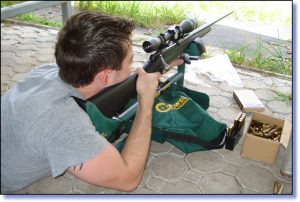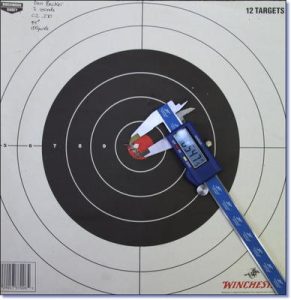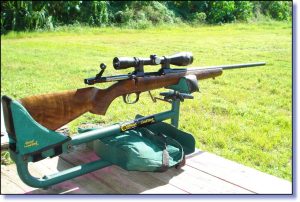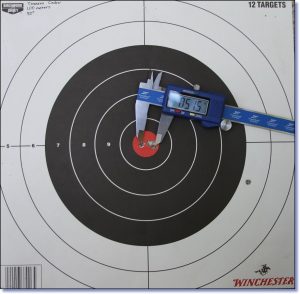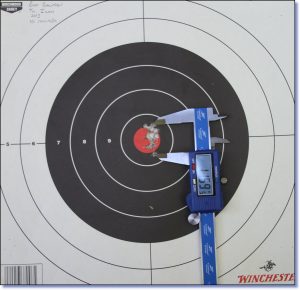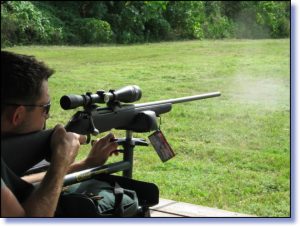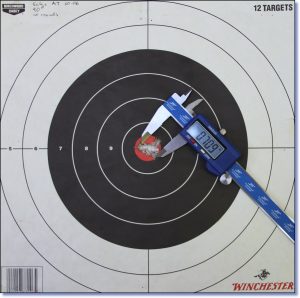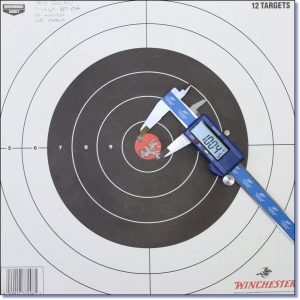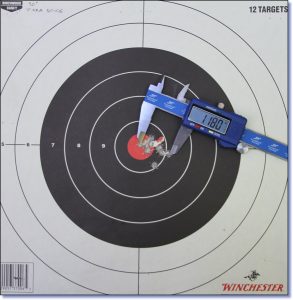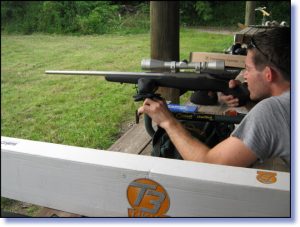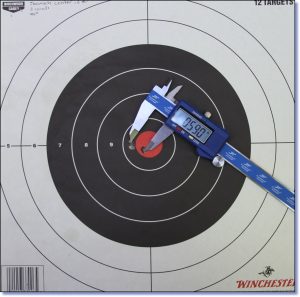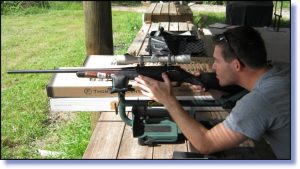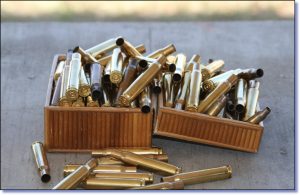|
|
Out of the Box Accuracy
Can Minute of Angle (MOA) Really Be True?
by Paul Helinski & Ben Becker
Pick up just about any gun magazine these days and you will see ads for MOA accuracy, guaranteed, out of the box. MOA means “minute of angle,” which is 1/60th of one degree of radius. It seems like a great selling point and I’m sure it sells a lot of guns, but I wondered if the claims were actually true. If you don’t understand MOA it is understandable. what does a fraction of a circle have to do with the accuracy of a rilfe? But we’ll get to that.
Not everyone is capable of shooting MOA, even with the most accurate rifle, so I employed our local neighborhood US Army Sniper (and GunsAmerica Magazine contributor), Ben Becker. The results are astounding. All of the rifles we tested (and we didn’t just test rifles that advertise MOA) shot into or nearly into a minute of angle at 100 yards. Some even did it for 10 and more rounds in a row, without cool down. I’ve said it before and I’ll say it again, we are living in the Golden Age of firearms manufacturing. This is incredible stuff.
Please don’t take this as a “head to head” comparison for these rifles against each other or against other rifles in the market we didn’t test. The list of guns we tested is in no way comprehensive. We were able to get rifles from Beretta (Sako, Tikka), Savage, Thompson Center and CZ. Noticeably absent are of course Remington, Browning, Winchester, Weatherby, Ruger and others. This article was not meant to be comprehensive. We just wanted to see what is going on out there in some quality production rifles and these are the ones we could get. There is no reason to believe that the rifles missing from this test wouldn’t perform just as soundly as the rifles we were able to shoot.
Accuracy Defined
The world “accuracy” as it applies to a rifle may not be what you think it is. Some people consider a rifle “accurate” if it shoots to point of aim. True “accuracy” is not whether it shoots to point of aim. That it just a matter of sight adjustment. True “accuracy” is how consistent, shot to shot, the rifle is, removing all human error and other variables.
No rifle is 100% accurate. Even if held in a vise and the trigger pulled by a robot, no rifle will shoot through the exact same hole every time. Even the most precise competition rifles may appear to be 100% accurate at 100 yards, but will show a sub-minute of angle deviation at 200 or 500 yards. A “minute of angle” or MOA, is 1/60th of 1/360th of a circle (each degree is split into 60 minutes), like degrees on a compass. The actual measured span of this type of angular measurement changes as you move further from the target. One minute of angle at 100 yards equals one inch (1.047 actually). At 200 yards this actual measurement on the target is two inches, three hundred is three inches, and so on. Yards and inches conveniently give this relationship. Think of it like the beam of a flashlight on a foggy day. As you get further away the light circle gets bigger on what it hits. This “minute of angle” span also gets bigger as you get further away. This is accuracy.
When a rifle is advertised as “MOA” out of the box, it is telling you that it is guaranteed to shoot a number of bullets, all human and environmental factors removed of course, into one inch at 100 yards. Some manufacturers don’t specify the number of bullets in a row they guarantee, some do. And sometimes that number is 3 and sometimes it is 5.
Real World Shooting
Accuracy only matters when you apply it to your actual application, or applications. Nobody buys a hunting rifle for it to just sit in the safe. You expect to and are going to be out hunting with it. What you hunt is going to determine how you expect a MOA rifle to perform. If you are a deer hunter, an advertised 3 shot MOA gun might be just fine. You don’t expect to take more than one shot ideally, and three shots in the space of two inches at 200 yards is surgical enough to get the job done for sure.
If you are hunting hogs, prairie dogs or other critters that don’t have bag limits and upon which you can stumble on a whole bunch of them hanging out for the pickings, 5 shots may not even be enough. How the barrel performs after several rounds heat the gun up will matter to you, and matter a great deal. And don’t discount the use of a modern hunting rifle as a tactical weapon. Accuracy is accuracy, and in a tactical situation, who knows what kind of sustained fire you might need out of the gun.
It would be much “safer” for us to just test these guns at 3 shots each, and we did start out the tests with 3 shot test targets. But we aren’t here for proving marketing claims. Aren’t you curious if the MOA guns are barely in the ballpark of MOA at 3 or 5 rounds, or if they consistently deliver MOA over 10 or more rounds? We were.
The good news is that the rifles did perform, not just in three and five shot groups, but also in ten and twenty shot groups. Holding even an inch and a half over 10 rounds with no cool down time is thought to be impossible for a “thin barreled” hunting rifle. But we proved that this new generation of rifle technology is like no other. You may not see it in any marketing claims, but in our basic testing with brown box Hornady Ammunition, we found that you can count on these guns even when you heat them up.
Our Test Rifles
The Simply Stunning Sako
Every article for GunsAmerica Magazine starts out as an idea. The Sako A7 was the impetus for this article. Beretta advertised extensively on GunsAmerica and used our On Demand system to sell these rifles for over a year. They are advertised at 5 shot MOA guaranteed. Made in Finland for decades, the Sako line is famous for quality and accuracy, but at $750 out the door, this price point was unheard of at the time for a 5 shot MOA guaranteed.
That made us very eager to get out and test this bargain price Sako. The results were stunning to say the least. Three shots, five shots, and even ten shots went into the same ragged hole, time after time after time. The adjustable trigger (that we never bothered adjusting) is an absolute pleasure to shoot and the gun has an easy and light feel. Beretta promises world class accuracy in this gun and I feel that they deliver it handily. It is a .30-06 for those who want to know.
Thompson Center/TC Arms – Master Gun Makers Indeed
The TC Icon is truly a best in class when it comes to fit and finish, but TC also promises a 3 shot MOA guarantee on this rifle. They call it the “Foundation for Accuracy” and the Icon utilizes their accuracy certified 5R rifling. We tested the stainless steel and synthetic stock version of the gun in .243. There is also a wood stocked model for all of you traditionalists out there.
What can you say when a rifle advertised at 3 rounds into an inch at 100 yards shoots into .559 inches at 100 yards over not 3 but 5 rounds? The Icon easily kept its promise for TC for accuracy, and even at 10 rounds it shot into 1.15 inches. This is with no cool down whatsoever, bang bang, bang, reload, bang, bang, bang, reload, bang, bang, bang, reload, bang. That three round magazine kills you, but at least you know you aren’t going to miss. And at just around a thousand bucks the Icon is a very special gun.
The TC Venture is perhaps the best value in a hunting rifle in America from what I have seen. You get the same “Master Gun Maker” fit and finish found in the Icon, and the guaranteed MOA, at half the price. The styling and finish aren’t as elegant as the Icon, but it is after all half the price. What a rifle for under $500!
We can’t find the 10 round target that we shot for this gun, which is a .270, and nobody remembers what the measurement was exactly, but it was under 1.5″ for 10 rounds. We did retain the 3 round target that we benchmarked all the rifles with at first however. As you can see in the picture, it was 3 rounds into .590 inches, like the Icon at 5 rounds, just over half an inch, with no cool down. Again, the promise made by TC is not only kept, but exceeded by almost double.
The Inexpensive Savage… is a Savage
The Savage Axis series carries an MSRP of $329. It is an entirely new design from Savage and has a top strap, unlike the famous Model 10/110, and a 4 round box magazine. Our model tested is a .30-06 and came with a carbon steel blue barrel and synthetic stock. If there was one rifle that should **not** have performed well it was this one. Savage makes no accuracy claims in its advertising or on the website. There is no patented Savage Accutrigger(TM) on the gun. And although Savage is known for accuracy above all, and the Axis barrel is free floated on the stock (theoretically reducing harmonics), this is a no frills hunting rifle at a no frills price. You would think that it would have no frills accuracy as well.
But you know what? This crazy little Savage put 20 rounds into a hole no bigger than a half dollar at 100 yards like it was born and bred to do it! For 3 rounds the Savage came in at .869 inches, not as good as I think it can do, and 10 rounds at exactly an inch, 1.004. Savage has always been known for being the Cadillac of out of the box accuracy in American rifles, but in a $329 rifle I felt that this level of accuracy was over the top. The Axis may be an entry level hunting rifle, but take it as an example of what you’ll discover in a quality American made Savage.
The Surprising CZ
The CZ American 550 is another rifle that is not advertised to be holding at MOA accuracy. You would think when picking it up that this is your grandfather’s old Pre-64 Winchester. The wooden stocked model we tested is absolutely gorgeous, with fine checkering and an old world feel that you only get with a factory that has been making Mauser action bolt rifles since before you were born.
You really wouldn’t think that a traditional, wooden stocked rifle, made by an old European rifle maker would deliver sub-MOA results out at the range, but for this rifle I knew it was going to perform before it even arrived. We had given away a CZ in .416 Rigby at the NRA Show this past year in Charlotte. When the winner received the rifle he emailed us his test target that came with the rifle. The test target had three rounds, each big enough to stick your pinky through, drilled into less than an inch center to center. On seeing this we sent a request into CZ to send a gun for this article. They did, and told us that all of their guns are test fired for accuracy, and they all shoot into less than an inch.
This test gun, a .270, bettered that by almost half. We fired 3 rounds at 100 yards into .547 inches, and the ten round group came in at just over an inch, at 1.22. Sniper accuracy out of an old world gun. That is amazing. The CZ isn’t a rifle that you see in every gun shop you walk into, but ask your local dealer to order you one. This rifle will not disappoint.
Tikka Makes the Grade… and Possibly More
The Tikka T3 Lite Stainless is the last gun in our test, and like the others it performed extremely well. Tikka is brought into the US by Beretta USA like the Sako, and they too are made in Finland on the same machinery that produces $3500 Sako 85s. The quality and workmanship are superb, and as a low priced rifle, the 3 shot MOA guarantee is surprising. Of all the rifles we were able to test, the Tikka was the one I was the most curious about. I can’t say I was surprised when it came in well under an inch for 3 rounds, but I was surprised when 10 rounds of .30-06 came in at 1.18 inches, with no cool down. The highest variance in that string was lateral, which it shouldn’t be on a 90 degree day in south Florida. It should string vertically because the barrel is hotter and more floppy. That suggests that it was human error opening the 10 round group to over an inch. Ben is darn good, but not perfect, and this is a rifle I would like to test again.
So if MOA Out of the Box is New, What Changed?
Even five years ago nobody would have expected to buy a rifle of the shelf and get the accuracy you see here in our tests for under $1000, which all of our rifles come in under. When several gun companies who have been making rifles for decades come out with advertisements that their out of the box guns are now shooting “MOA,” something has to have changed. You used to have to pay a gunsmith hundreds of dollars to custom bed your rifle to get MOA, and as you will see from my tests, most of these rifles are shooting sub-MOA right out of the box with regular thickness barrels. So what changed?
- Metallurgy and Machining – When we think of those deer rifles that shot into 2 inches if you were lucky, we are thinking about old guns. New guns are made with new alloys and more importantly, CNC cutting tools and advanced measurement tools that are head and shoulders above the old stuff. There is a whole new body of knowledge about how to make metal things more consistent, and capabilities to finer tune the modern rifle to record out of the box accuracy. I don’t think better accuracy happened by accident. New knowledge and capabilities have meant better products, and we reap the results.
- Ammo, Ammo, Ammo – In the interest of full disclosure, Hornady is the official ammo sponsor of GunsAmerica and we did use Hornady Ammo for almost all of our testing. But we entered into the agreement with Hornady for a reason. They introduced all of shooting sports to an entirely new generation of consistent ammunition. You may think that all ammunition is equal but it is not. There are “tolerances” to any manufacturing process. At the cyclic rate that ammunition machines run at, variances in everything from powder charge to seating depth to jacket thickness can be huge, and effect accuracy a great deal. Before the Hornady revolution (pun intended), inconsistency was more the norm in factory ammo than consistency. If you couldn’t get better than a 3 inch group out of your old deer rifle, most likely at least half the problem was the ammo. Today’s rifle manufacturer relies on consistent ammo to get those “Guaranteed MOA” claims, and the consistency of Hornady ammo was proven out in every one of our test rifles. We’ll stick with the brown box.
- Consumer Awareness and New Priorities – This is a case of which came first chicken or the egg. But when it comes to MOA accuracy, I think the custom rifle market had a lot to do with the improvements in production rifles. When a large percentage of the market is buying old Mauser actions and having them mated with custom barrels and custom bedded stocks to produce a $1500 MOA hunting rifle, the product development people at the manufacturers saw an opportunity. Seeing that both metallurgy and ammo had come so far, they pushed their own abilities to do what the custom rifle people were already doing, and a whole new era of the hunting rifle market was born.
Are All Rifles Like This Now?
We tested 6 rifles from 4 manufacturers. All of them performed well above what you would think for out of the box hunting rifles. Can you extrapolate this to the entire gun industry and assume that all modern bolt rifles are producing this kind of accuracy when fed consistent Hornady Ammunition? We don’t know. But now that we have measured the results for these rifles maybe we will take the time and follow up this article with offerings from Remington, Winchester, Browning, Ruger, Weatherby, Mossberg and anyone else who comes a calling. Stay tuned!
Can I Shoot MOA?
This is the million dollar question. Now that you know your rifle can most likely easily shoot MOA, the question becomes can you shoot MOA. Notice for these tests that even Ben, a trained US Army Sniper with more than one tour of duty under his belt used a Lead Sled from Caldwell to hold the gun steady and absorb recoil. He did this because eliminating human factors is really the only way you can test the hardware for what it is, hardware. Trigger control and sight picture also factor into what you will actually be able to shoot with your gun, as well as the quality of your optics and mounts. Ben has already begun a series on the methods he learned in US Army Sniper School. Also check out our article this month on the Telydyne Tech Straightjacket. We sent them the Sako A7 from this article and the Savage Axis as well and had them modify their guns with their exciting technology. Then we brought them to the 500 yard range and mounted a $2000 Vortex Razor optic on them for true long range shooting. You can never stop learning when it comes to shooting and GunsAmerica Magazine is a great resource to become a sub-MOA shooter.

